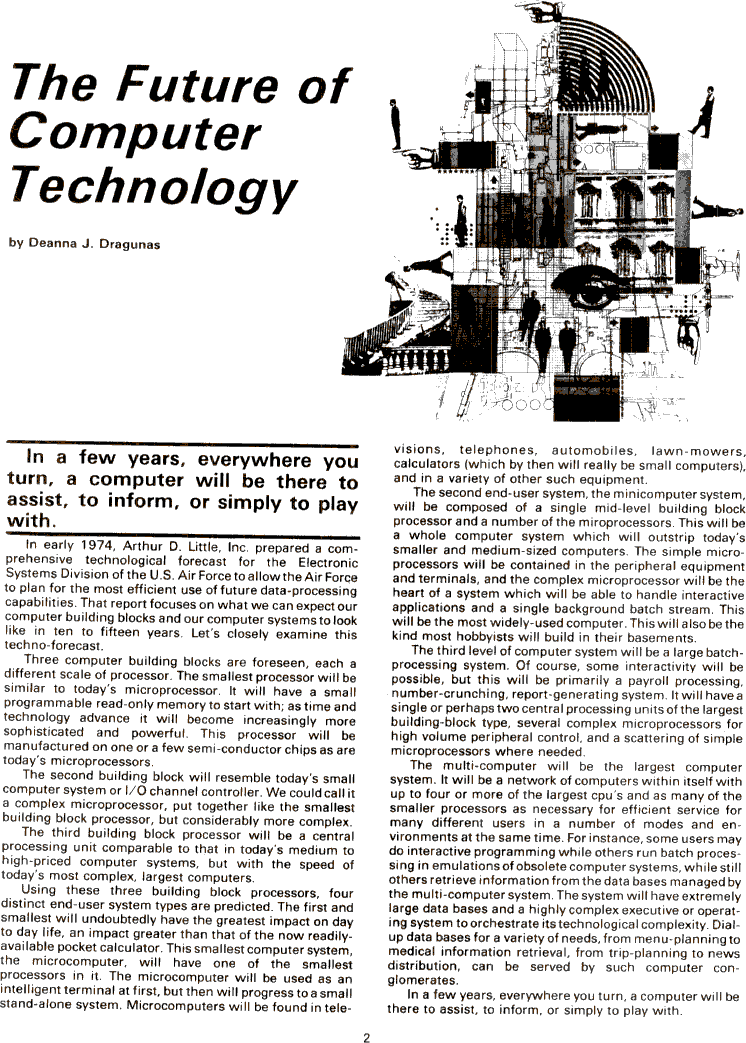by Deanna J. Dragunas

The Future of Computer Technology by Deanna J. Dragunas [Image] In a few years, everywhere you turn, a computer will be there to assist, to inform, or simply to play with. **** ln early 1974, Arthur D. Little, Inc. prepared a comprehensive technological forecast for the Electronic Systems Division of the U.S. Air Force to allow the Air Force to plan for the most efficient use of future data-processing capabilities. That report focuses on what we can expect our computer building blocks and our computer systems to look like in ten to fifteen years. Let's closely examine this techno-forecast. Three computer building blocks are foreseen, each a different scale of processor. The smallest processor will be similar to today's microprocessor. It will have a small programmable read-only memory to start with; as time and technology advance it will become increasingly more sophisticated and powerful. This processor will be manufactured on one or a few semi-conductor chips as are today's microprocessors. The second building block will resemble today's small computer system or I/O channel controller. We could call it a complex microprocessor, put together like the smallest building block processor, but considerably more complex. The third building block processor will be a central processing unit comparable to that in today's medium to high-priced computer systems, but with the speed of today's most complex, largest computers. Using these three building block processors, four distinct end-user system types are predicted. The first and smallest will undoubtedly have the greatest impact on day to day life, an impact greater than that of the now readily available pocket calculator. This smallest computer system, the microcomputer, will have one of the smallest processors in it. The microcomputer will be used as an intelligent terminal at first, but then will progress to a small stand-alone system. Microcomputers will be found in televisions, telephones, automobiles, lawn-mowers, calculators (which by then will really be small computers), and in a variety of other such equipment. The second end-user system, the minicomputer system, will be composed of a single mid-level building block processor and a number of the miroprocessors. This will be a whole computer system which will outstrip today's smaller and medium-sized computers. The simple microprocessors will be contained in the peripheral equipment and terminals, and the complex microprocessor will be the heart of a system which will be able to handle interactive applications and a single background batch stream. This will be the most widely-used computer. This will also be the kind most hobbyists will build in their basements. The third level of computer system will be a large batch processing system. Of course, some interactivity will be possible, but this will be primarily a payroll processing, number-crunching, report-generating system. lt will have a single or perhaps two central processing units of the largest building-block type, several complex microprocessors for high volume peripheral control, and a scattering of simple microprocessors where needed. The multi-computer will be the largest computer system. It will be a network of computers within itself with up to four or more of the largest cpu's and as many of the smaller processors as necessary for efficient service for many different users in a number of modes and environments at the same time. For instance, some users may do interactive programming while others run batch processing in emulations of obsolete computer systems, while still others retrieve information from the data bases managed by the multi-computer system. The system will have extremely large data bases and a highly complex executive or operating system to orchestrate its technological complexity. Dial-up data bases for a variety of needs, from menu-planning to medical information retrieval, from trip-planning to news distribution, can be served by such computer conglomerates. In a few years, everywhere you turn, a computer will be there to assist, to inform, or simply to play with.

